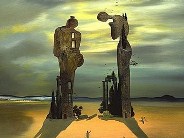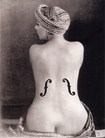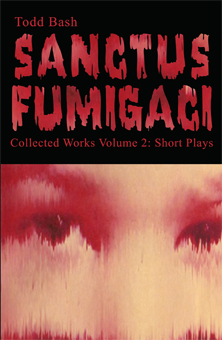

SURREALIST FILMS
Part One: Surrealist Films 1923-1930
Part Two: The Cinema of Luis Buñuel
Part Three: Other Directors Influenced by Surrealism
Surrealist Films 1923-1930
Le Retour A La Raison (1923)
Director: Man Ray
Running time: 3 minutes; B&W; silent


Two stills from Man Ray's Le Retour A La Raison.
Entr'acte (1924)
Director: René Clair
Script: Francis Picabia, René Clair
Photo: Jimmy Berliet
Music: Henri Sauguet
Cast: Jean Börlin, Inge Friss, Francis Picabia, Marcel Duchamp, Man Ray, Darius Milhaud, Erik Satie, Mamy
Country: France
Language: French
Running time: 22 min; B&W; silent


Two stills from René Clair's Entr'acte. Left: Marcel Duchamp & Man Ray play chess. Right: Francis Picabia and Erik Satie fire a cannon.
Description: Directed by René Clair, Entr'acte was originally made to fill an interval between two acts of Francis Picabia's new ballet, Relâche, at the Théâtre des Champs-Elysées in Paris in 1924.
Among the scenes: Two men approach a canon and fire it; Rifle-range dummies sway in the wind; A dancing ballerina turns into a strange bearded man; Two men (Marcel Duchamp & Man Ray) play a game of chess on a roof-top terrace; A funeral procession, moving in slow motion, follows a coffin pulled by a camel.
Emak-Bakia (1926)
Director: Man Ray
Script: Man Ray
Photo: Man Ray
Cast: Kiki of Montparnasse (Girl with painted eyes), Jacques Rigaut
Country: France
Language: French
Running time: 18 min; B&W; silent


Two Stills from Man Ray's Emak Bakia.
Note by Man Ray: "Even though my surrealist friends who I invited to a showing of Emak Bakia were not very enthusiastic, I thought I had complied with all the principles of Surrealism: Irrationality, automatism, psychological and dream-like sequences without apparent logic, and complete disregard for conventinal storytelling."
L'Étoile De Mer (1928)
Director: Man Ray
Script: Robert Desnos
Photo: Man Ray
Cast: Kiki of Montparnasse; Robert Desnos
Country: France
Language: French
Running time: 17 minutes; B&W; silent


Two stills from Man Ray's surrealist masterpiece L'Étoile De Mer, scripted by
Robert Desnos.
Synopsis: Photographed through textured glass, creating a dream-like effect, a man and woman are seen standing on a deserted road; They retire to a bedroom, where the woman undresses, but the man suddenly bids her farewell and leaves; The man receives a starfish in a jar, which he examines with fascination; The woman returns to the bedroom with a knife, intent on murder, and finds the starfish; Some time later, the man and woman meet again, but on this occasion, the woman is accompanied by another male; Alone in his room, the man hypnotically stares at the starfish, reflecting, "How beautiful she was...How beautiful she is"; The woman appears in a mirror, which violently shatters.
Un chien andalou (1929)
Director: Luis Buñuel
Script: Luis Buñuel & Salvador Dalí
Photo: Albert Duverger
Cast: Pierre Batcheff; Simone Mareuil; Luis Buñuel; Salvador Dalí
Country: France
Language: French
Running time: 16 minutes; B&W; silent
Click here to read the shooting script.




Four stills from Luis Buñuel's masterpiece Un chien andalou.
L'Age d'or (1930)
Director: Luis Buñuel
Script: Luis Buñuel & Salvador Dalí
Photo: Albert Duverger
Cast: Lya Lys; Gaston Modot; Max Ernst; Pierre Prévert
Country: France
Language: French
Running time: 63 minutes; B&W; silent/sound

Two stills from Buñuel's infamous L'Age d'or.
Among the scenes: Archbishops turn into skeletons; A party is held at a palatial estate; A gamekeeper shoots his son with a rifle over a minor incident; In a garden, two lovers pursue their fetishes and desires, while music by Wagner is performed at a concert nearby; One of the lovers, enraged over being torn from his rendezvous by a phone call, hurls several objects out a window, including an archbishop; In a final vignette inspired by de Sade's 120 Days of Sodom, the survivors of an orgy emerge from a castle, including the Duc de Blangis, who strongly resembles Jesus Christ.
Other Surrealist Film Projects
Antonin Artaud wrote several film scenarios, though only one, The Seashell and the Clergyman, was actually produced. Directed by Germaine Dulac in 1928, this drama follows the erotic hallucinations of a priest, who lusts after the wife of a general. Reportedly, Artaud was unhappy with Dulac's realization of his script, and the premiere was met with angered protests by the Paris Surrealist group.
Man Ray directed another film, Les Mystères du Château de Dé (1929), though it was more straight-forward than his other cinematic efforts. The producer was Vicomte Charles de Noailles, who also financed Buñuel's L'Age d'or.
Federico García Lorca wrote a film script, Trip to the Moon, in 1929. It shares a great deal in common with Un chien andalou, made earlier that year by the poet's close friends Buñuel and Dalí. Sadly, the project was never produced during Lorca's lifetime.
Click here to read Trip to the Moon.
Dada filmmaker Hans Richter wrote, produced and directed Dreams Money Can Buy in 1947. The experimental effort featured a series of dream-like sequences, done in collaboration with Max Ernst, Marcel Duchamp, Man Ray, Alexander Calder, Darius Milhaud and Fernand Léger.
The Cinema of Luis Buñuel
Luis Buñuel is perhaps the greatest surrealist filmmaker, and one of the iconic directors in cinema history. His career spanned a half century, from his early masterpieces Un Chien andalou and L'Age d'or made with Salvador Dalí, to his award-winning films of the 1970s, The Discreet Charm of the Bourgeoisie and The Phantom of Liberty. Buñuel's cinematic world is one filled with humor and revolt, deformity and desire, fetishes and dreams. Below you will find a complete list of his films, followed by some recommended books about the director.

FILMOGRAPHY
Early Period
Un Chien andalou (An Andalusian Dog) (1929) France
L'Age d'or (The Golden Age) (1930) France
Las Hurdes (Land Without Bread) (1932) Spain
Middle Period
Gran Casino (1946) Mexico
El gran calavera (The Great Carouser) (1949) Mexico
Los olvidados (The Young and the Damned) (1950) Mexico
The Devil and the Flesh (Susana/Demonio y carne) (1950) Mexico
The Daughter of Deceit (Don Quintin el amargao) (1951) Mexico
A Loveless Woman (Una mujer sin amor) (1951) Mexico
Mexican Bus Ride (Subida al cielo) (1951) Mexico
The Brute (El bruto) (1952) Mexico
Robinson Crusoe (1952) US-Mexico
El (This Strange Passion) (1953) Mexico
Illusion Travels by Streetcar (La ilusion viaja en tranvia) (1953) Mexico
Wuthering Heights (Abismos de pasion) (1954) Mexico
River of Death (El rio y la muerte) (1954) Mexico
The Criminal Life of Archibaldo Cruz (1955) Mexico
Cela s'appelle l'aurore (1955) France-Italy
La Mort en ce jardin (Death in the Garden) (1956) France-Mexico
Nazarin (1958) Mexico
La Fievre monte a El Pao (1959) France-Mexico
The Young One (La Joven) (1960) US-Mexico
Late Period
Viridiana (1961) Spain-Mexico
The Exterminating Angel (El angel exterminador) (1962) Mexico
Diary of a Chambermaid (1963) France-Italy
Simon of the Desert (Simon del desierto) (1965) Mexico
Belle de jour (1967) France-Italy
La Voie lactee (The Milky Way) (1969) France-Italy
Tristana (1970) Spain
The Discreet Charm of the Bourgeoisie (1972) France
The Phantom of Liberty (Le Fantome de la liberte) (1974) France
That Obscure Object of Desire (1977) France-Spain


SELECTED BOOKS ABOUT BUÑUEL
Autobiogrphy
My Last Sigh Vintage Books 1983
Objects of Desire (Conversations with Buñuel) Marsilio Publishers 1992
Prose
An Unspeakable Betrayal University of California Press 2000
Biographies and Film Studies
Luis Buñuel by Francisco Aranda; Da Capo Press 1976
Buñuel by John Baxter; Fourth Estate 1994
Luis Buñuel by Raymond Durgnat; University of California Press 1968
Buñuel: 100 Years Museum of Modern Art, New York 2001
Luis Buñuel: The Complete Films Taschen 2005
Film Scripts
Un chein andalou & L'Age d'Or Lorrimer Publishing 1969
Belle de Jour Lorrimer Publishing 1971
Tristana Lorrimer Publishing 1971
The Exterminating Angel and Los Olvidados Lorrimer Publishing 1972
Other Directors Influenced by Surrealism
Note: The following is, in no way, an exhaustive list. It is intended as a starting point for those interested in exploring films and directors whose work, in one way or another, might be considered "surrealist" in nature.
Lindsay Anderson (if..., O Lucky Man); Fernando Arrabal; Bertrand Blier
(Buffet Froid); Patrick Bokanowski (L'Ange); Maya Deren (Meshes of the Afternoon, At Land); Federico Fellini (8½, City of Lost Women); Marco Ferreri;
Jean-Luc Godard (Weekend); Peter Greenaway (Drowning By Numbers);
Wojciech Has (The Saragossa Manuscript, The Hourglass Sanatorium);
Jaromil Jires (Valerie and Her Week of Wonders); Alejandro Jodorowsky;
Jean-Pierre Jeunet & Marc Caro (Delicatessen, The City of Lost Children);
David Lynch (Eraserhead); Sergei Parajanov (The Color of Pomegranates);
Peter Ibbetson (1935); Roman Polanski (The Tenant); Alain Resnais (Hiroshima mon amour, Last Year in Marienbad); Andrei Tarkovsky (The Mirror, Nostalghia).
All of the biographies and book lists found on this site, as well as texts found on the HOME, HISTORY, COMMENTARY & PERIODICALS pages, are the sole property of Surrealism-Plays.com.
